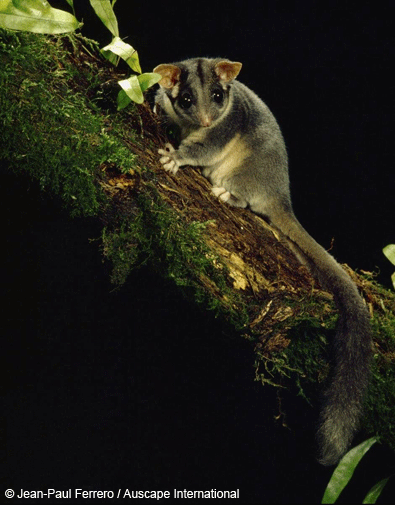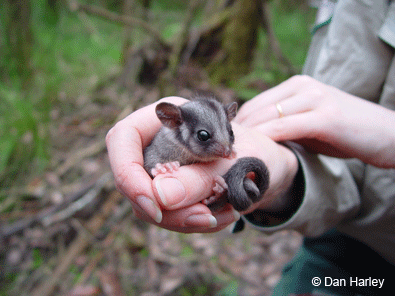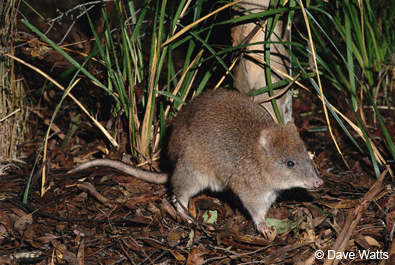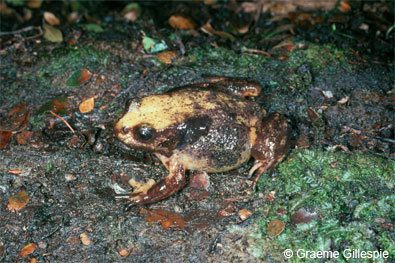Three top ranking Australian EDGE species have been given a fighting chance for survival following the Victorian government’s landmark decision to set aside 75,000 ha of forest for their protection.
Leadbeater’s possum (54th on the mammal list), the long-footed potoroo (70th on the mammal list) and the Baw Baw frog (25th on the amphibian list) are three of Australia’s most iconic endangered species.
Announced yesterday, the plan includes a 30,000-hectare reserve in central Victoria for the possum, 40,000 hectares in East Gippsland and the state’s north-east to protect the long-footed potoroo, and 5500 hectares to protect the most significant habitat of the Baw Baw frog.
“This package is a powerful way of protecting the habitat of endangered species and ensuring their future protection,” Environment Minister Gavin Jennings said.
Environment groups have welcomed the announcement by the Brumby government and the Department of Sustainability and Environment for Victoria’s only native marsupial and amphibian species. The 75,000 hectares of reserves lifts protection for the species against extinction drivers such as woodchipping, fire management and feral animals.
In some cases, these reserves have taken a decade to design but it’s been worth the wait to get it right’ said Sarah Rees, Director of MyEnvironment.
The tiny nocturnal Leadbeater’s possum is endemic to Victoria, and is one of the state’s faunal emblems. The species’ relies on mature trees, such as the mountain ash, which can take up to 200 years to grow. These trees contain hollows in which the possums make their nests. Populations of the species have declined rapidly as a result of the loss of mature trees to logging, wildfires and other forest disturbances.
The endangered long-footed potoroo, also known as “rat kangaroo”, plays an important role in its forest ecosystem, helping to disperse the spores of the underground-fruiting fungi on which it feeds. These fungi have developed a symbiotic relationship with the shrubs and trees of the forest, maintaining their health by supplying nutrients and helping to prevent disease. Previously, most of these rabbit-sized marsupials occurred within timber production forest.
The Critically Endangered Baw Baw frog is Victoria’s only native amphibian. It has all but disappeared, with the population falling to just 250 individuals from a wild population of over 10,000 in the 1980s. Although the causes of the decline are still unclear, protecting the species’ habitat is a step in the right direction to ensuring the little frog has a future.
“Now that the reserve system is finalised we hope our State Government will turn its attention and further resources to the other critical actions that need to be done to preserve this endangered species and all of the other forest species it shares its habitat with for future generations” said Sera Blair, president of Friends of the Leadbeaters Possum group.
“The biggest threat for these and other endangered species is now climate change. What these species need now is the protection of all old growth forests from woodchipping”, said The Wilderness Society’s Victorian Campaigns Manager Gavan McFadzean.
“Forest protection against these threats will help secure their future. It’s not just about protecting animals, these areas are also our water supply catchments and carbon stores”, said Sarah Rees.
“The practical action by the Victorian government to protect our faunal emblem offers a sensible approach to the management of species under fire and provides for the continuation of ecosystems that enable us to live such producing water, oxygen, rain and climate regulation”.
“These new forest reserves are also critically important habitat for endangered animals like native owls, fish and gliders. Our frogs inhabit healthy water catchments, our ground and tree dwellers like the long-footed potoroo and Leadbeaters possum, require multi-aged forests that are still under threat from logging in eastern Victoria”.
Future actions required include linking protected forest patches and fundraising for monitoring the effectiveness of these mitigation efforts. For more information please contact Sarah Rees (sarah@tcha.org.au).



